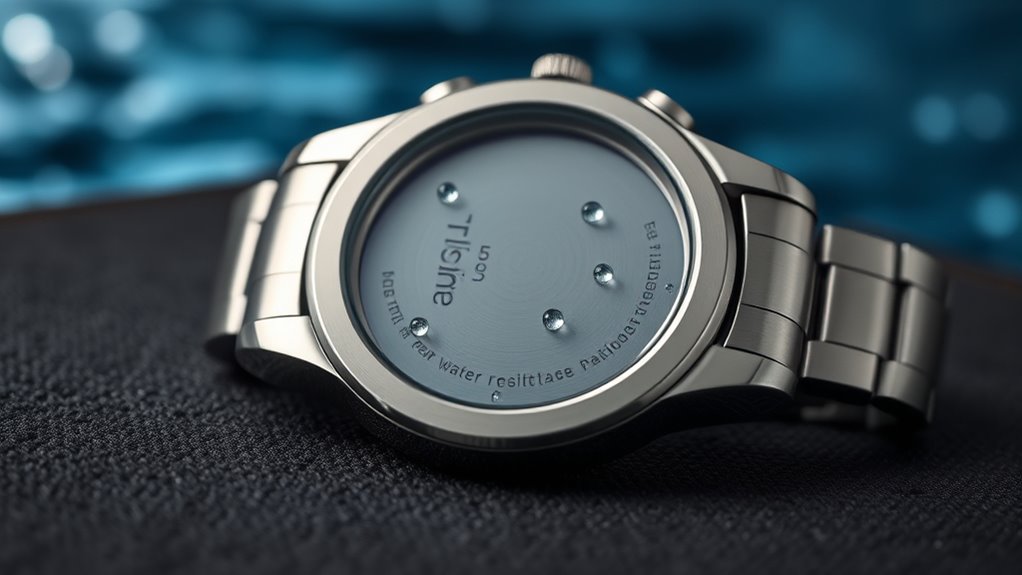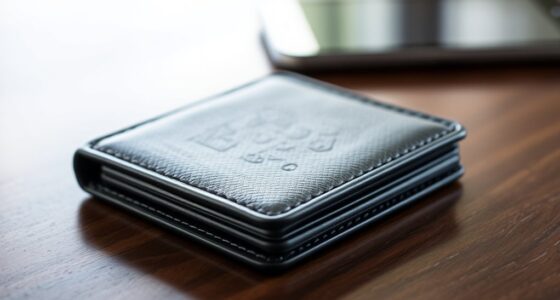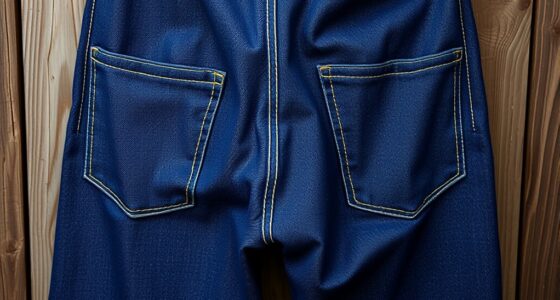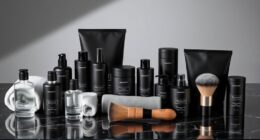Water resistance ratings show how well your watch can handle water exposure, often listed as ATM, BAR, or meters. These ratings indicate the pressure a watch can withstand or the water depth it can handle, guiding you on whether it’s suitable for swimming, diving, or just splashes. Keep in mind, seals can weaken over time, so understanding these numbers helps safeguard your watch—discover more to ensure you choose the right level for your lifestyle.
Key Takeaways
- Water resistance ratings like ATM, BAR, and meters indicate how much water pressure a watch can withstand for specific activities.
- Ratings are determined through pressure tests, depth simulations, and seal evaluations to ensure durability.
- No watch is fully waterproof; water resistance can weaken over time and with exposure to chemicals or extreme temperatures.
- Different ratings suit various activities: splash resistance for daily use, higher ratings for swimming or diving.
- Regular maintenance, seal checks, and understanding rating units help protect your watch from water damage.
Understanding Water Resistance: What Do the Numbers Mean?

When it comes to water resistance ratings on watches, the numbers you see—like 30m, 50m, or 100m—actually indicate how much water pressure the watch can withstand. These ratings relate to the case durability, showing how well the watch can resist water intrusion under certain conditions. Keep in mind, though, that water resistance isn’t permanent; the case seals can degrade over time. To maintain your watch’s water resistance, follow simple maintenance tips such as getting the seals checked regularly and avoiding unnecessary exposure to water if your watch isn’t rated for high depths. Proper care ensures the case remains durable, preventing water damage and extending the life of your timepiece. Understanding these ratings helps you protect your watch effectively. Incorporating mindfulness practices like regular maintenance routines can help you stay aware of your watch’s condition and ensure its longevity.
How Are Water Resistance Ratings Tested?
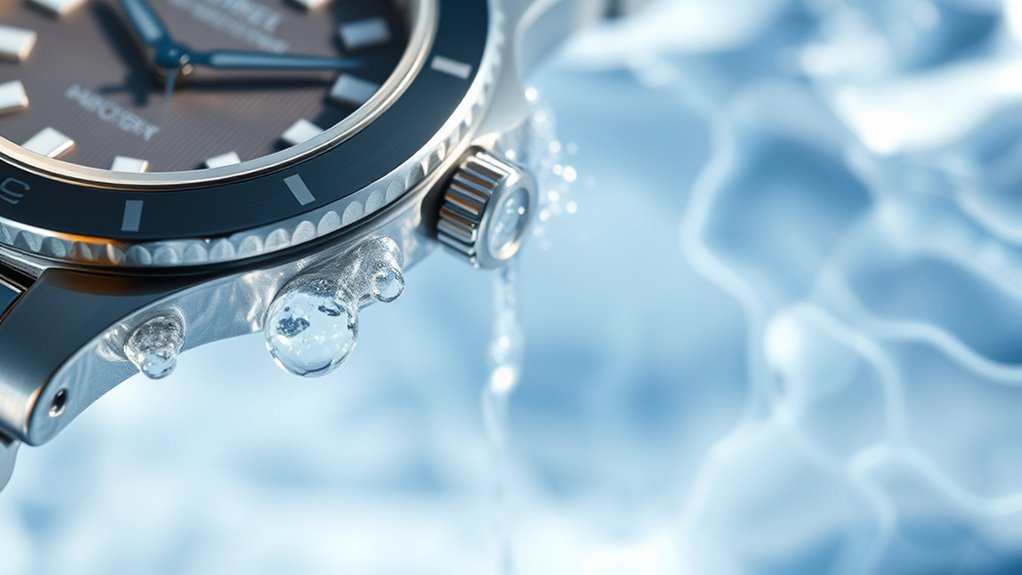
Water resistance ratings are determined through rigorous testing methods that simulate real-world conditions. You’ll find that pressure testing procedures assess how well a watch withstands force, while depth simulation methods replicate submersion scenarios. Additionally, sealing material evaluation guarantees that the watch’s components remain secure and waterproof under various stress levels. Proper testing ensures that the water resistance rating accurately reflects the watch’s filtration and sealing capabilities across different environments.
Pressure Testing Procedures
Pressure testing is the primary method used to determine a watch’s water resistance rating. During this process, the watch is placed in a controlled environment where it’s subjected to increasing water pressure. This simulates the conditions the watch would face underwater. The test checks the seal integrity of the watch, guaranteeing that all gaskets and seals are holding properly. If the watch withstands the pressure without allowing water inside, it passes the test and receives its rated resistance level. If not, adjustments are made, and testing is repeated. This method provides a reliable assessment of how well the watch can resist water ingress. It’s a vital step for manufacturers to certify the watch’s durability and guarantee it performs under specified conditions. Water resistance ratings are determined through these tests, providing consumers with confidence in their watch’s ability to withstand wet environments.
Depth Simulation Methods
Depth simulation methods are essential for accurately testing a watch’s water resistance ratings by mimicking real-world underwater conditions. These tests often involve pressure chambers that recreate the pressure experienced at specific depths. During testing, the watch is placed inside a controlled environment where the pressure is increased gradually to simulate immersion. You might imagine being inside a large pressure chamber, where conditions are carefully monitored. Common depth simulation procedures include:
- Filling the chamber with water or air to simulate submersion.
- Increasing pressure to match target depths.
- Holding the pressure for a set time to test durability.
- Releasing pressure and inspecting for leaks or damage.
- Calibration of instruments ensures that the pressure levels are precise and reliable throughout the testing process.
These steps ensure the watch can withstand the pressures encountered underwater without compromising its integrity.
Sealing Material Evaluation
To accurately assess a watch’s water resistance, technicians focus on evaluating the sealing materials that prevent water ingress. They test the material durability by examining how well the seals withstand pressure and environmental factors. The process involves inspecting gaskets, O-rings, and case back seals for cracks, deformation, or degradation. Material selection is critical, as high-quality sealing materials ensure long-term durability. The table below summarizes key aspects:
| Sealing Material | Durability Testing | Common Applications |
|---|---|---|
| Rubber Gaskets | Pressure and age resistance | Waterproof cases |
| Silicone Seals | Flexibility, chemical resistance | Dive watches |
| Viton O-rings | Extreme temperature and wear resistance | Professional-grade watches |
This evaluation guarantees your watch maintains its rated water resistance over time. Choosing the right sealing material is essential for ensuring the longevity of water resistance in watches for different environments.
Common Water Resistance Ratings and Their Levels of Protection
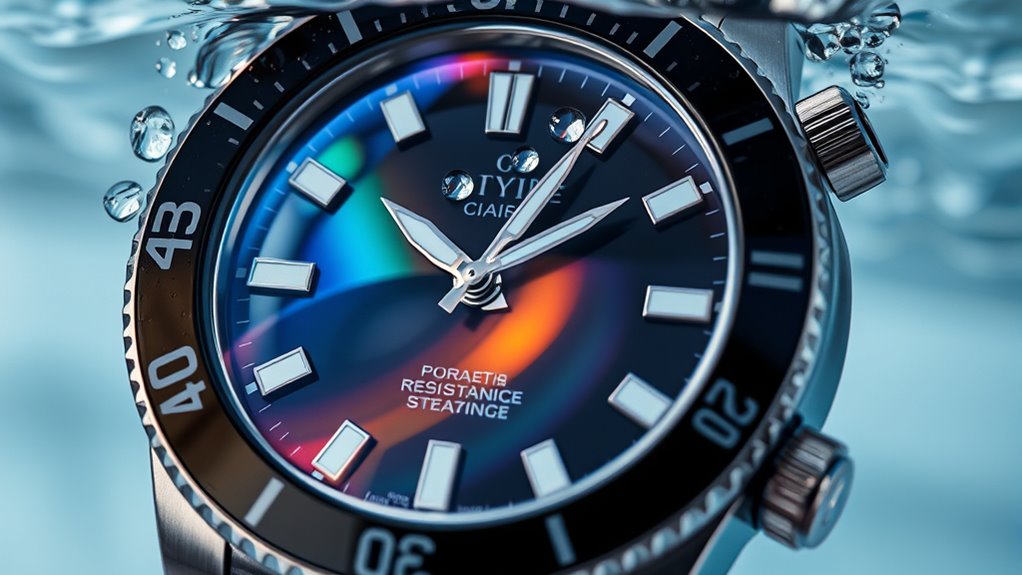
You’ll find that some watches are designed to withstand splashes and sweat, making them suitable for everyday wear. Others are built for more demanding activities, like swimming or snorkeling, offering greater protection underwater. Knowing these ratings helps you choose the right watch for your specific needs, whether it’s casual protection or serious water exposure. Additionally, understanding inspirational quotes about fatherhood can remind you of the importance of support and resilience in challenging situations.
Splash and Sweat Resistance
Splash and sweat resistance are designed to protect your device from everyday exposure to water and moisture, such as rain, handwashing, or light splashes. This level of protection helps prevent corrosion and reduces the need for frequent maintenance routines. Imagine:
- Your watch enduring a sudden splash while washing your hands.
- It resisting sweat during a workout session.
- Rain lightly hitting your wrist without issue.
- You wiping it off quickly after a splash.
While these features guard against minor moisture, they don’t make your device waterproof. To maintain protection, regularly clean and dry your watch, avoiding prolonged exposure to moisture. Proper maintenance routines help ensure your device continues to resist splashes and sweat effectively.
Diving and Deep Water
When it comes to diving and deep water activities, understanding water resistance ratings is vital for guaranteeing your device can handle more than just splashes. Ratings like 200 meters or more are designed for professional diving, where marine biology and water chemistry play pivotal roles in equipment performance. Deep water exposes devices to high pressure and varying salinity levels, which can affect seals and materials. Knowing the specific rating helps you choose a watch that withstands the conditions you’ll face underwater. For example, a 300-meter rating indicates suitability for technical diving, where pressure increases markedly with depth. Always verify if the watch’s water resistance is tested for true diving conditions, not just surface water exposure, to assure your device’s reliability beneath the waves. Additionally, understanding water resistance ratings can prevent equipment failure and ensure safety during your aquatic adventures.
What Does ATM, BAR, and Meters Signify?

Have you ever wondered what the numbers and units on a water-resistant watch truly mean? When you see ATM, BAR, or meters, they indicate different ways of measuring pressure and depth. Here’s what they represent:
- ATM (atmospheres): Equal to 10 meters of water pressure, reflecting how much force your gasket materials can withstand.
- BAR: Slightly higher than ATM, with 1 BAR roughly equal to 10 meters of water depth.
- Meters: Indicates actual water depth your watch can handle; for example, 50 meters means it’s suitable for swimming.
- Pressure Calibration: Ensures the watch’s gasket materials are tested accurately to match these ratings, confirming water resistance under specific conditions.
- Water-Resistant Standards: These ratings are based on industry testing protocols, which standardize how resistance levels are measured and reported.
Understanding these units helps you gauge your watch’s capabilities and limitations.
Water Resistance vs. Waterproof: Is There a Difference?
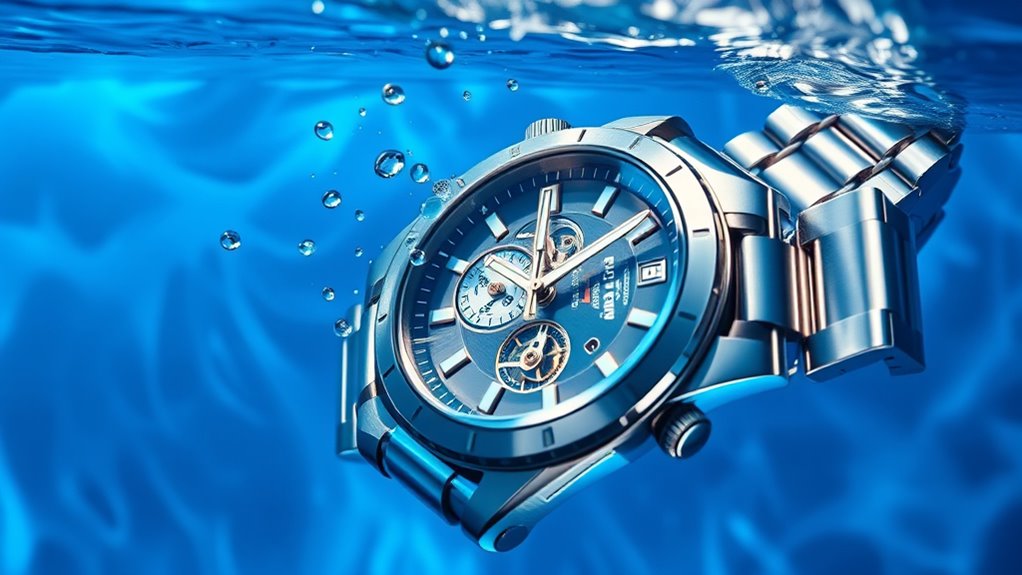
Understanding water resistance ratings helps you choose the right watch for your activities, but it’s important to know that “waterproof” and “water-resistant” aren’t interchangeable terms. Water resistance indicates a watch’s ability to withstand water ingress under specific conditions, but it doesn’t mean it’s completely immune to water. A watch labeled “waterproof” suggests it’s designed for full protection, but no watch has perfect mechanical durability against water pressure. Most water-resistant watches can handle splashes or brief dips, but prolonged exposure or deep submersion can compromise their seals. Remember, water ingress can damage internal components, so always respect the rated depths. Additionally, water resistance ratings can vary over time due to wear and tear, so regular maintenance is essential to ensure continued protection. Recognizing this difference helps you avoid overestimating your watch’s capabilities and ensures proper care to maintain its integrity.
Limitations of Water Resistance Ratings

While water resistance ratings provide a helpful guideline, they have notable limitations that you should be aware of. First, environmental impacts can weaken seals over time, making your watch less resistant despite its rating. Second, manufacturing standards vary; some brands may not meet strict quality controls, risking water ingress. Third, daily activities like showering or swimming can stress seals beyond their rated depth. Fourth, aging materials degrade, especially if exposed to chemicals or extreme temperatures, compromising water resistance. Additionally, robotic maintenance in manufacturing can influence the quality control processes that ensure water resistance standards are met. These factors highlight that ratings are not foolproof indicators of a watch’s capability. Relying solely on ratings overlooks environmental impacts and manufacturing standards that influence performance. Always consider these limitations to avoid damage and ensure your watch’s longevity.
Tips for Caring for Your Water-Resistant Watch
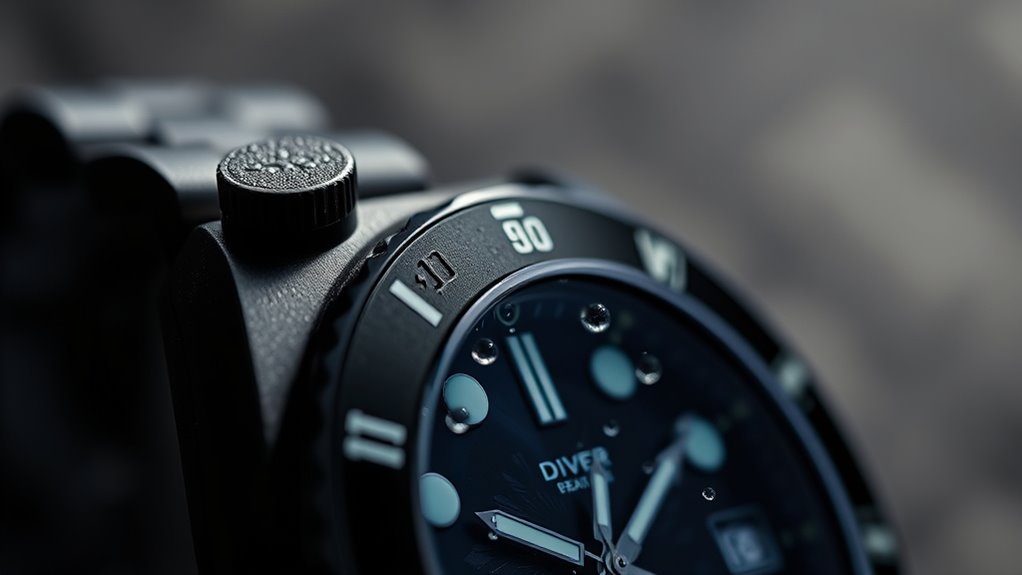
Proper care is essential to maintain your water-resistant watch’s performance over time. Follow simple care tips and maintenance routines to guarantee longevity. Always rinse your watch with fresh water after exposure to saltwater or chlorine, and dry it thoroughly. Check the crown and buttons regularly to confirm they’re fully secured. Avoid pressing buttons underwater, even if your watch is rated for it. Store your watch away from extreme temperatures and strong magnetic fields. Schedule professional pressure tests every 1-2 years to verify water resistance. Regularly monitor your watch’s water resistance to ensure ongoing protection. Here’s a quick overview:
| Care Tips | Maintenance Routines | Key Considerations |
|---|---|---|
| Rinse after exposure | Regular pressure testing | Avoid extreme temperatures |
| Dry thoroughly | Battery replacement | Keep crown secure |
| Store properly | Seal check-ups | Limit exposure to chemicals |
Choosing the Right Water Resistance for Your Lifestyle
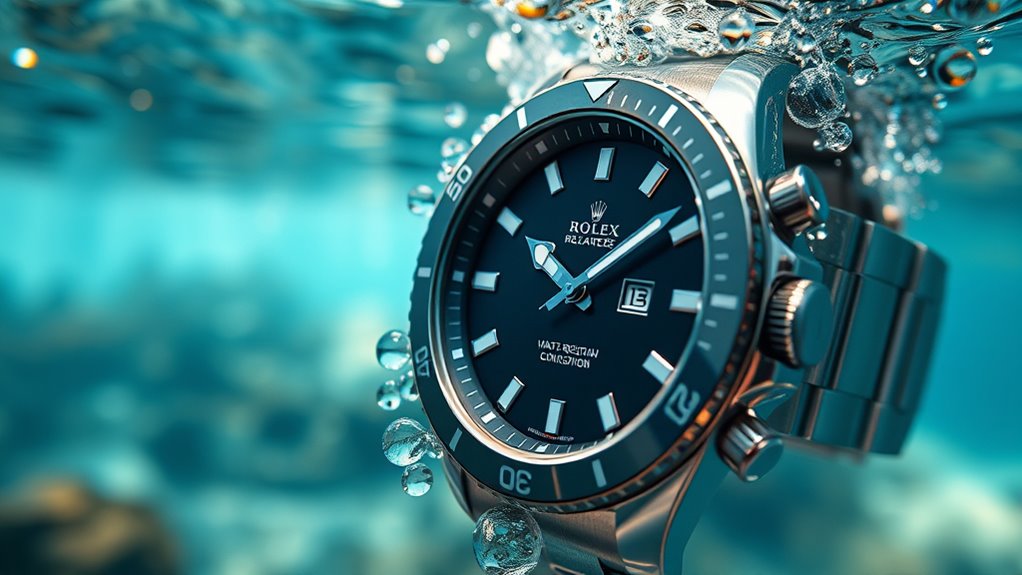
Choosing the right water resistance level depends on your daily activities and how you plan to use your watch. If you want a stylish accessory that aligns with current fashion trends, select a watch with a water resistance suited for your lifestyle. Imagine:
Choosing the right water resistance ensures your watch stays stylish and protected during your daily activities.
- Wearing a sleek, water-resistant watch during your gym sessions without worry about sweat.
- Swimming in the pool, knowing your watch can handle brief submersion.
- Diving into adventures with a high water resistance rating for deeper water activities.
- Wearing your watch daily, with confidence that it withstands rain or accidental splashes.
- Understanding that water resistance ratings are based on standardized testing to ensure your watch performs as expected in various conditions.
Matching the water resistance with your lifestyle ensures watch maintenance remains simple and your accessory stays trendy. Choose wisely to keep your watch both fashionable and functional, avoiding unnecessary damage.
Frequently Asked Questions
Can Water Resistance Ratings Change Over a Watch’s Lifespan?
Water resistance ratings can decrease over a watch’s lifespan due to water resistance degradation. Factors like aging seals, impacts, or exposure to chemicals can weaken the watch’s resistance. To maintain its water resistance, you should follow maintenance tips such as regular seal checks, avoiding extreme temperature changes, and having the watch tested annually. Proper care helps make certain your watch remains water-resistant and functions well over time.
How Do Temperature Changes Affect Water Resistance?
Temperature fluctuations can affect your watch’s water resistance by causing pressure effects on seals and gaskets. When temperatures rise, the materials expand, potentially creating tiny gaps that allow water to seep in. Conversely, cold temperatures can cause contraction, making seals less effective. To protect your watch, avoid exposing it to extreme temperatures or rapid temperature changes, especially when swimming or diving, to maintain its water resistance over time.
Are There Specific Activities That Void a Watch’s Water Resistance?
Think of your watch’s sealing integrity as a fragile promise—you must honor it. Activities like diving, swimming in hot tubs, or exposing it to high-pressure water can void its water resistance, risking water exposure. Even showering or washing dishes might compromise the seal over time. Be mindful, because pushing the limits of your watch’s resistance weakens its ability to keep water out when you need it most.
What Signs Indicate a Watch’s Water Resistance Has Diminished?
You’ll notice water resistance diminishes if you see signs like condensation or fogging inside the watch, which indicates leak detection issues. Corrosion signs, such as rust or discoloration around the case or crown, also suggest reduced water resistance. If your watch feels unusually loose or the seals look worn, don’t ignore these clues. Regular maintenance can help preserve its water resistance, preventing further damage.
Do All Watch Brands Test Water Resistance the Same Way?
Think of watch brands as artists with unique brushes; their watch testing methods vary to reflect their brand standards. Not all brands test water resistance the same way—some use pressure chambers, while others rely on real-world simulations. This diversity guarantees each brand’s standards match their craftsmanship, so your watch’s water resistance can differ depending on the testing process. Always check the specific brand’s testing methods to understand their water resistance reliability.
Conclusion
Remember, your watch’s water resistance is like a friendly handshake—it’s there to help, but it’s not invincible. By understanding its limits and caring for it properly, you can enjoy your adventures with confidence. Think of it as a loyal companion, always ready to join your journey—just don’t forget to give it the occasional check-up. With a little care, your watch will keep up with your active life, splash after splash.
